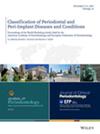Silk-fibroin chitosan film for palatal wounds: Material development, in vitro study, and pilot clinical trial
Abstract
Background
In the present study, we aim to assess a novel silk-fibroin (SF) chitosan (CH) film to treat oral mucosa wounds.
Methods
The SF/CH films, sterilized with 130 Gy in a gamma cell, were subjected to tests for thickness, water vapor permeability, tensile strength, elongation, and swelling as well as scanning electron microscopy. Additionally, in vitro cytotoxicity and genotoxicity were evaluated using human epidermal keratinocytes, human foreskin fibroblasts, and human gingival fibroblasts. A pilot clinical trial was conducted with 10 patients who underwent a free gingival graft procedure for socket preservation. The palatal wound healing was evaluated through clinical, patient-centered, immunological, and histological assessments.
Results
The SF/CH film exhibited a thickness of 187.5 ± 8.0 µm and water vapor permeability of 15.87 ± 7.52 g mm m2 day−1 kPa−1, and microscopy revealed a uniformly rough surface. A flexible scaffold was observed (Young's modulus = 1.74 ± 0.90 MPa) with 1% of water absorption within 2 h. The in vitro analysis showed increased cell viability and low genotoxicity for epithelial and fibroblast cells. For the clinical assessments, wound closure was 28.06 ± 4.3mm2 and 0.95 ± 1.9mm2 after 7 and 14 days, respectively. The immunological assay exhibited a decrease in tissue inhibitor of metalloproteinase-1 (TIMP-1) (p = 0.02) and an increase in macrophage inflammatory protein-1 alpha (MIP-1α) (p = 0.008) from Day 3 to Day 7. Histology showed the absence of residual biomaterial after 12 months. Complete epithelialization was reached on Day 21, and no tissue thickness loss was observed after 90 days. Patients reported low discomfort and minimal analgesic intake.
Conclusion
Within the present study's limits, SF/CH film may be useful to help in the healing of wounds on the palatal mucosa. Further clinical investigations are required.
Plain Language Summary
This study aimed to evaluate a novel silk fibroin and chitosan film for treating palatal mucosa wounds. The films were sterilized, tested for physical properties, such as thickness, tensile strength, elongation, water vapor permeability, and swelling, and subjected to scanning electron microscopy. In vitro tests using human oral and skin cells assessed the film's toxicity. Ten patients undergoing graft-harvesting procedures received the film, and their healing was monitored clinically, immunologically, and histologically. The film demonstrated appropriate physical properties, and laboratory results indicated high cell viability and low toxicity. Clinically, the wounds demonstrated considerable closure by Day 7 and almost full closure by Day 14. Immunological assessments indicated elevation in some healing markers, and histology revealed no residual biomaterial at 12 months post treatment. Complete epithelialization occurred by Day 21, with no tissue thickness loss at 90 days, and patients reported low discomfort and minimal analgesic use. These findings suggest that the silk-fibroin/chitosan film may be beneficial for oral wound healing, warranting further clinical studies to confirm its efficacy.




 求助内容:
求助内容: 应助结果提醒方式:
应助结果提醒方式:


